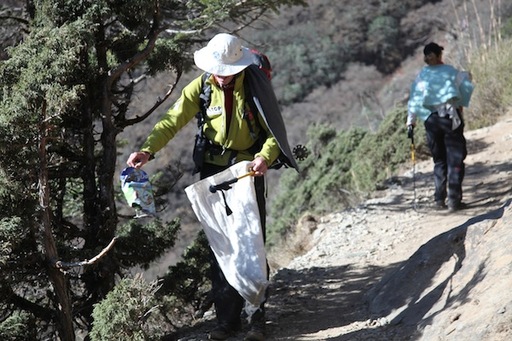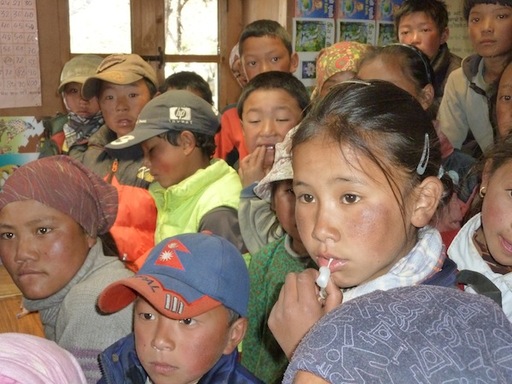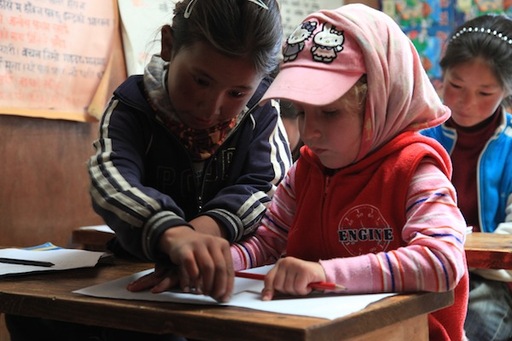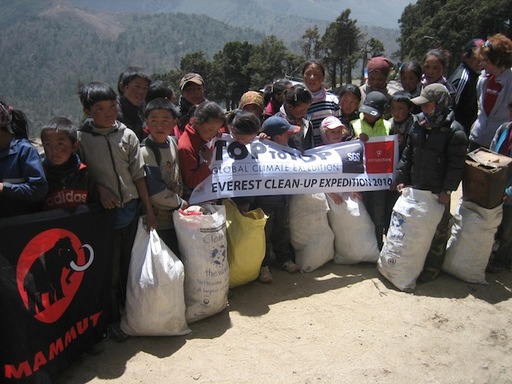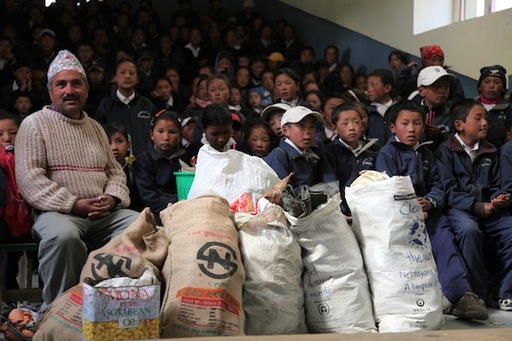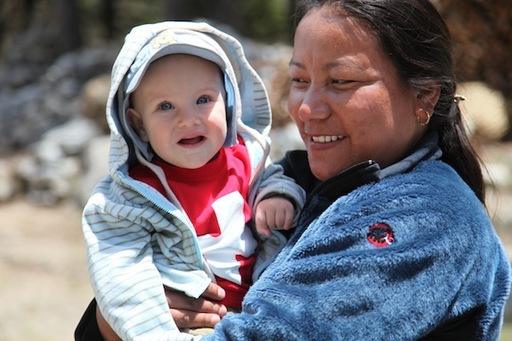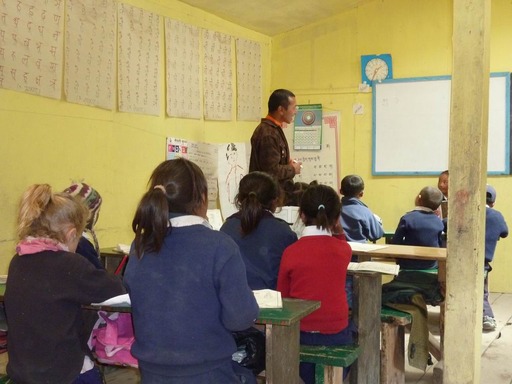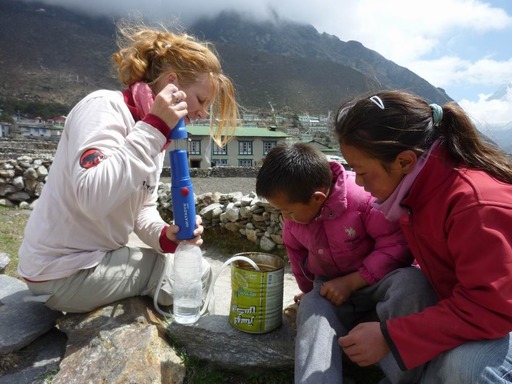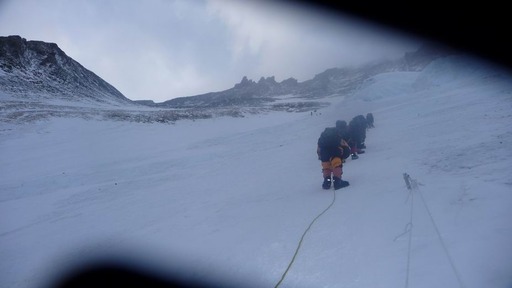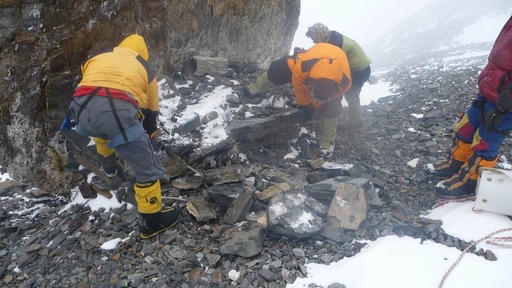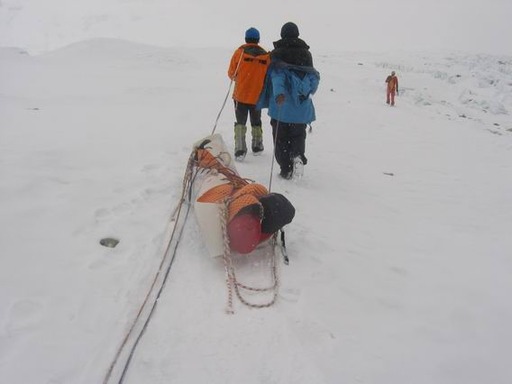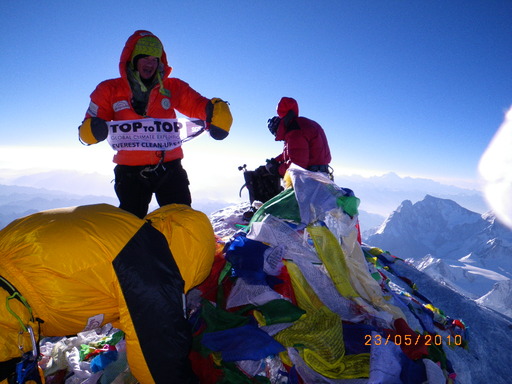May 3, 2010
School visits in Pangboche and Khumjung
The time spent at Everest Base Camp (although cold!) was an unbelievable experience for everyone. We were even lucky enough to see a temporary photo exhibit titled "Rivers of Ice - Vanishing Glaciers of the Greater Himalaya" in one of the tents. The exhibit was sponsored by the Richard D. Bass Foundation and is a collection of photographs by the talented David Breashears, alongside archival photographs taken over the past century by some of the worlds greatest mountain photographers. The comparison of the black and white archive material recaptured by David demonstrates the dramatic loss of ice during the last decades, and is a great example of someone using his art to educate and bring awareness about the effects of global climate change.
(For more information email info@davidbreashears.com)
With the clean up finished, it was time at last to turn around and start descending down the stunning pathways of the Himalaya. Our first stop after Base Camp was Lobuche, 7 km further down and 450 meters lower in altitude. Then from there, we took one of the most amazing pathways we have taken so far, which made us all feel like we were walking along the sky on the mountains edge to Pangboche.
But even the most breathtaking scenery doesn't deter litterers from dropping trash like Coke bottles and tobacco packets along the way. Thankfully everyone continued to fill up their sacks leaving an even more pristine pathway behind.
When we did arrive in Pangboche, after the 12 km trek up and down the mountain sides, we were very excited to see that our guest house, which was situated on one of the highest points of the town, had a stunning view of both Mt Kantega and Ama Dablam. But one building that was even higher in altitude than the guest house - the local school, which was overlooking the whole village.
Pangboche school, like many other schools in the region, is independently funded through the Sir Edmund Hilary Foundation. At the time of our visit, it was still under construction. Dario and Sabine organised a presentation, so the following day we walked up the steep path to the top of the hill and met the approximately 30 students who studied there, varying in age from 3 to 12. As tradition demanded, we started the presentation with a Swiss song, which was enthusiastically met with a beautiful musical Nepali reply from the class!
After the drawing contest, a competition was made with the aim to collect as much garbage as possible, and the classes were split into teams. The eager children clutched their sacks and ran outside to clear away the bounty of plastic, empty cans and bottles from their Rhododendron woodland environment. We were so proud and impressed at the mentality and positive attitude of the students, congratulations to everyone involved!
So, after the 2 days spent in the clouds of Pangboche, we continued on, this time to the little village of Phortse Thanga, tucked cosily in between the valley by the cold river. Decorated with Rhododendrons, Blossoms, Iris flowers and something which in Nepali is called "Tangyum", we finally felt like we had stepped off the ice and snow back into the more habitual land of the lower altitudes. But not for too long, the next day we climbed up the other side of the valley, back to the familiar town of Khumjung, which resides at 3780 m in altitude.
In contrast to Pangboche, the school in Khumjung is well established and has over 300 students, many of them living there. A presentation was given, and well installed electricity and a projector allowed the students to share in the journey of the TOPtoTOP expedition so far.
A clean up was also performed by the mass of children, this time including high school students up to 16 /17 years old. In no time at all their bags were full and the garbage was cleared from their playground and surroundings.
The most enthusiastic class was awarded with some new pencils and writing materials donated by two of the volunteers (Vreni and Margrit) and their family back home in Switzerland. Thanks guys!
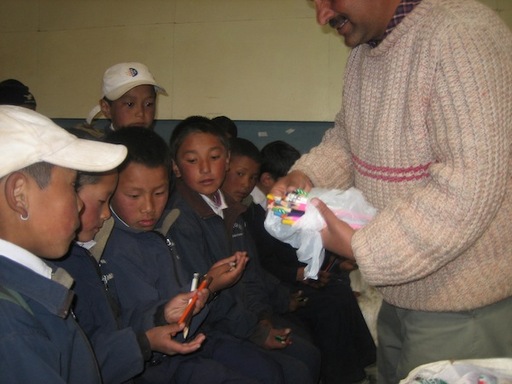
The TOPtoTOP project and presentation really helped to raise garbage awareness, and helped the students learn not only about the sustainability of their natural environment but the sustainability of the tourism industry on which the town certainly is dependent on to a relevant degree.
Again, thanks to everyone involved with the project here in Khumjung and the continuing clean up from Everest Base Camp through the Khumbu Valley and beyond. We continued to meet an amazing number of inspiring people along the way who are interested in the goals of the expedition, including a pair of passionate students studying sustainability of the environment and community development in the Himalaya region. We wish you both the best of luck in your studies and look forward to hearing your solutions for what lies ahead.
And once again, we must thank our sponsors who have made this entire Everest Clean Up Expedition possible. The ongoing support of SGS & Victorinox, along with Mammut, and our other friends at Heimgartner Fahnen, Megasol and Katadyn is invaluable. The impact the expedition has had on the locals and communities in the Himalaya region is viable only by the impact of the generous support from our sponsors. So thank you once more!
All the best for now,
the TOPtoTOP team 2010.
May 13, 2010
Clean up Everest
Download the latest film from Jacqui here.
 Noe mit 8 Monaten im EBC auf 5400 m beim Aufräumen mit Mutter Sabine und Schwester Salina. Andri war sehr beschäftigt, mit dem Pickel den Abfall auszugraben.
Noe mit 8 Monaten im EBC auf 5400 m beim Aufräumen mit Mutter Sabine und Schwester Salina. Andri war sehr beschäftigt, mit dem Pickel den Abfall auszugraben.
=> Noe with 8 month in EBC on 5400 m, collecting trash with mother Sabine and sister Salina. Andri uses the ice axe to get the garbage out of the ice.
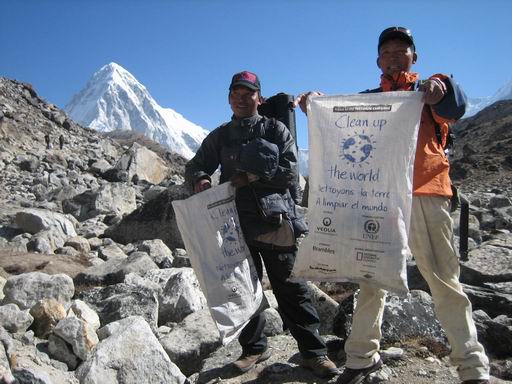 Aufräumaktion mit Unterstützung von Sherpas und Touristen
Aufräumaktion mit Unterstützung von Sherpas und Touristen
=> Clean up with support from sherpas and tourists
Seit dem 17. März haben die TOPtoTOP Mitglieder mit Einheimischen beinahe alle Trekkingpfade im Khumbu Valley nach Abfall durchkämmt bis auf den Island Peak und Lobuche Peak.
=> Since the 17th of March TOPtoTOP members together with locals were cleaning nearly all trekking path in the Khumbu Valley as far as up to Iceland Peak and Lobuche Peak
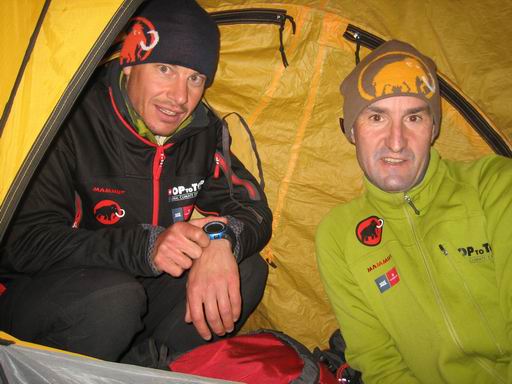 Alexander und Peter in unser Zelt kurz vor der Besteigung des Island Peak
Alexander und Peter in unser Zelt kurz vor der Besteigung des Island Peak
=> Alexander and Peter in our tent in Island Peak BC
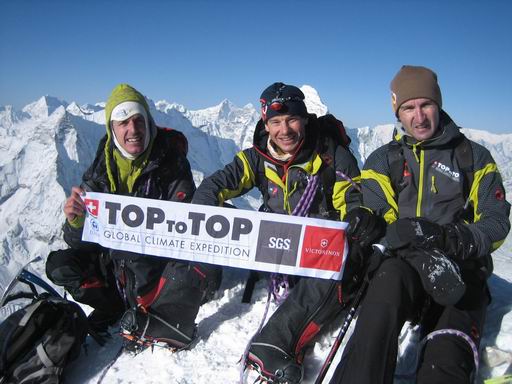 Dario, Alexander und Peter auf dem Iseland Peak auf ca. 6200m
Dario, Alexander und Peter auf dem Iseland Peak auf ca. 6200m
=> Dario, Alexander and Peter on the summit of Island Peak$
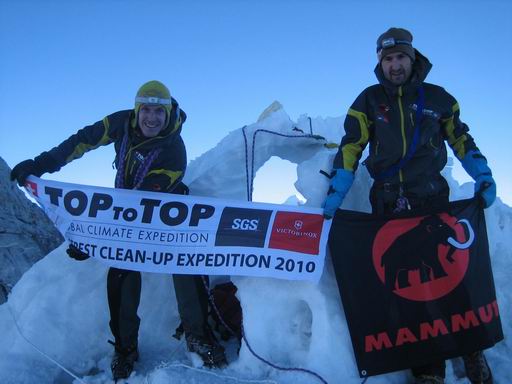 speed-Besteigung: 6 h morgens auf dem Lobuche Peak auf ca. 6200m
speed-Besteigung: 6 h morgens auf dem Lobuche Peak auf ca. 6200m
=> fast ascent: 6 a.m. on Lobuche Peak
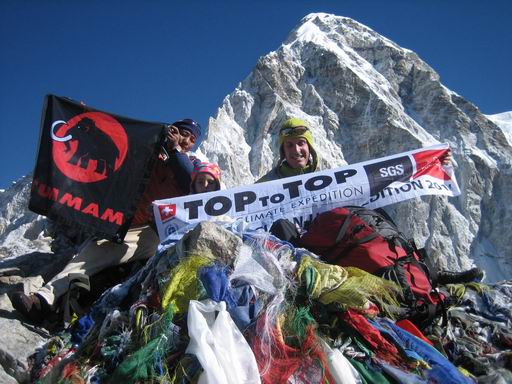 Salina kurz nach ihrem 5-jährigem Geburtstag mit Dario auf dem Mount Kalapathar auf über 5500 m
Salina kurz nach ihrem 5-jährigem Geburtstag mit Dario auf dem Mount Kalapathar auf über 5500 m
=> Salina after her 5th anniversary with father Dario on Mount Kalapathar over 5500 m
 Auf dem Trekk fanden wir viele Plastikflaschen und Büchsen und so gar Teile eines Helikopters
Auf dem Trekk fanden wir viele Plastikflaschen und Büchsen und so gar Teile eines Helikopters
=> On the trek there were a lot of plastic bottles and tins and even parts of a helicopter
 Im Basislager war es hauptsächlich Material früherer Expeditionen
Im Basislager war es hauptsächlich Material früherer Expeditionen
=> in the EBC we collected mostly trash from previous expeditions
Nach den Clean ups auf verschiedenen Trecks und der Aufräumaktion im Everest Basislager, wo Noe als Jüngster den Camp-Altersrekord brach, verabschiedeten wir uns von Jacqui, Margrit und Peter.
=> After the Clean ups on different treks and the clean up event in the EBC, we said goodbye to Jacqui, Margrit and Peter. Noe made a new record in EBC: he is the youngest ever in the Everest Base Camp.
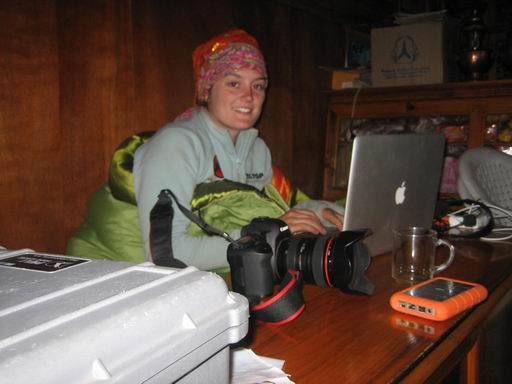 Kamerafrau Jacqui am editieren
Kamerafrau Jacqui am editieren
=> film maker Jacqui in action on 4000 m
Sabine, Salina, Andri und Noe hausten sich im Sherpadorf Khumjung ein, wo Salina die Schule besuchen darf. Das Dorf liegt auf knapp 3900 m über Meer.
=> Sabine, Salina, Andri und Noe put up their „Base Camp" in the Sherpa village Khumjung on nearly 3900 m, where Salina joined the school.
Im ganzen Dorf gibt es nur sehr wenig Wasser. Sabine muss nun, nachdem sie Noe 3 Wochen im Tragetuch über Pässe bis ins Everest Basislager getragen hat Wasser schleppen für die Wäsche von 3 Kindern. Dank Katadyn hat sie immer gutes Trinkwasser und bewahrt die Kinder vor Durchfallerkrankungen. (26) Noe macht die ersten Schritte in Khumjung dank Unterstützung von Andri und Salina.
=> In the village there is a shortage of water. Sabine was already carrying Noe to the EBC and now she has to carry the water for the washing. Thanks to Katadyn she has always good drinking water for the children. Noe made his first steps thanks to the support of Salina and Andri. 
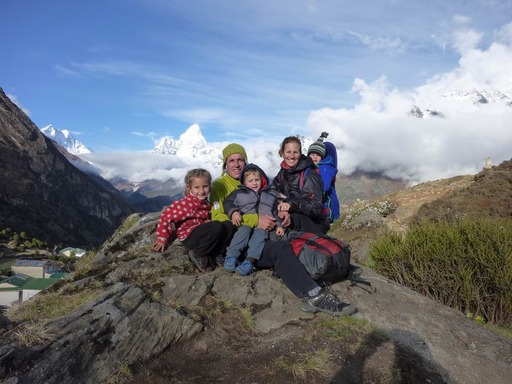
Abschied von der Familie in Khumjung mit Ana Dablam im Hintergrund
=> Goodbye from family with Khumjung and Ana Dablam in the background
Für alle war der Abschied schwer und es flossen einige Tränen. Alexander und Dario machten sich wieder auf den Weg zurück ins Basislager für das Clean Up über dem EBC und der Bergung eines
verunglückten Schweizers, der im Südsattel auf 8000 m begraben liegt.
=> It was hard for all to say goodbye. Alexander und Dario went back to EBC for the Clean Up above Base Camp and the rescue of the Swiss climber, who died 2 years ago and is lying on South Col on 8000 m.
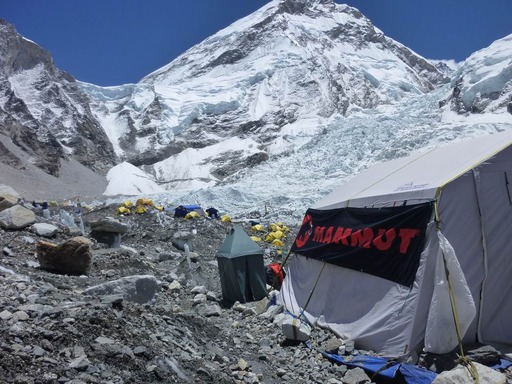 unser Hauptzelt im Everest Base Camp (Mammut)
unser Hauptzelt im Everest Base Camp (Mammut)
=> our main tent at EBC (Mammut)
 Alexander im Ice fall
Alexander im Ice fall
=> Alexander in the ice fall
Nach dem Basislager kommt die erste Hürde, der Ice fall, den wir zusammen mit 2 russischen Bergsteiger durchkletterten. Alexander und Dario liessen das Lager 1 aus und schafften es bis ins Lager 2 auf ca. 6500 m. Einer der russischen Kletterer aus St. Petersburg, war schon 4 Mal im Lager 2 und hatte Schwierigkeiten mit atmen; er war aber sehr hilfsbereit und half uns über die Leitern und sah, dass Dario's Steigeisen etwas aufgegangen sind.
=> We climbed the Ice fall above EBC together with 2 Russian climbers. Alexander and Dario continued to Camp 2 on approx. 6500 m. One of the Russian climbers from St. Petersburg had difficulties with birthing although he has been in Camp 2 4 times. He was very helpful climbing over the ladders and saw that something was wrong with Dario's crampons.
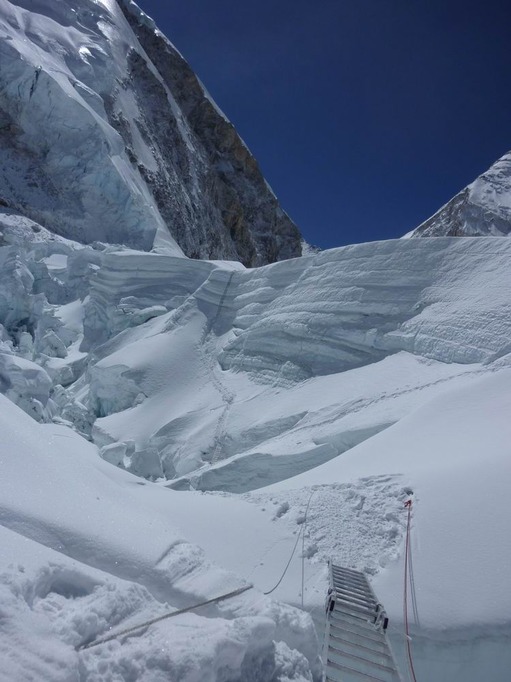 Leitern im Ice fall
Leitern im Ice fall
=> ladders in the Ice Fall
Im Lager 2 war es dann vorbei mit Aufräumen, da sich das Wetter verschlechterte. Es begann zu winden und schneien und wollte nicht mehr aufhören, so dass wir mehr als 24 h in unserem Zelt gefangen waren.
=> There was no chance to clean, because of the weather conditions. It started to blow and snow and we could not leave our tent for 24 h.
Als es aufklarte, hatte Alexander immer noch etwas Kopfweh, Dario war sich nicht sicher über die Lawinengefahr in der Lhotse Flanke und der Abfall lag unter dem Schnee. So entschieden wir das Wetterfenster zu nutzen und abzusteigen. Kaum im Basislager verschlechterte sich das Wetter wieder und 2 Tage später hörten wir, dass unser russischer Freund auf ca. 7500 m gestorben ist. Wir sind sehr traurig...
=> When it stopped snowing, Alexander had still some headache, Dario was not sure about the avalanche risk in the Lhotse Face and the trash was lying under the snow: We decided to profit from the weather window and turn back. Just back in EBC the weather condition turned bad again and 2 days later we heard that our Russian friend died on approx. 7500 m. We are very said.....
Im Augenblick ist es oben am Berg sehr stürmisch. Im Cap 2 soll unser Zelt beschädigt worden sein. Meteotest in Bern teilte uns mit, dass erst nach dem 20sten Mai die Winde abnehmen. Dies gab Dario Zeit zu seiner Familie nach Khumjung (in einem Tag ca. 2000 hm und ca. 40 km) abzusteigen und diesen Report zu schreiben, bevor ein weiterer Anlauf versucht wird.
=> At the moment is is very windy above EBC. In Camp 2 our tent might be damaged. Meteotest in Bern reported high winds till the 20th of May. With this forecast Dario went down to his family in Khumjug (2000 hm and approx. 40 km in 1 day) to see his family and write this report. He and Alexander plan to go back to EBC to try again in the next days.
Im nächsten Report mehr über die Bergung des Schweizers und Russen.
=> In the next report more about the rescue of the Swiss and Russian climber.
Herzlichen Dank unseren Sponsoren von Dario und Alexander direkt unter dem Everest:
Thanks again to our sponsors from Dario and Alexander direct under the Everest summit:
 SGS, Victorinox...
SGS, Victorinox...
May 25, 2010
Rescue on Everest
Download here the latest media artical
TOPtoTOP (Dario) was coordinating the rescue of a Swiss who died on a previous expedition to Everest. The honor goes to 8 Sherpa under the lead of Jyamchang Bhote from the Agency "Active Holidays". In mid conditions on the 4th of May at 2 a.m., they started climbing from camp 2 on 6400 m up to the South Col on 8000 m, where the Swiss was laying in a stone grave. They get there already at 1 p.m. carrying all rescue gear including a slide; - Normal climbers need 2 days to get so high...
They had 1 1/2 hours of hard work in thin air to open the grave with their ice axes and extract the body. Around 3 p.m. they wrapped him in a slide.
It was very difficult to the yellow band, especially in traverses. They have to build ankers in the Lhotse Face and abseiled the body in total 50 times! At 1 a.m. they arrived at the bergschrund of the Lhotse Face and left them there and went back to camp 2 for a short nap, before they returned and slide him down to camp 2 the next morning.
They have been very tired and hungry after more than 24 hours hard work and no warm food. Then the weather turned bad and the wind picked up so that there was no chance to fly the body out from camp 2. The alternative was to climb with 80 kg body trough the very dangerous Khumbu Icefall with deep crevasses and ceracs and ice towers collapsing anytime.
 Khumbu icefall in the back and Everest Base Camp in front
Khumbu icefall in the back and Everest Base Camp in front
To expose loyal Sherpas to such a risk, when you have the alternative of flying the body out by helicopter under the lead of the world famous mountain rescue experts in the name of the Swiss Bruno Jelk and Gerold Biner (Air Zermatt) is stupid!
They are both in Nepal as volunteers to build up a Nepali rescue system and found in the Nepali helicopter company FISHTAIL AIR and in the two excellent pilots Sabin Basnyat and Siddhartha the right partners.
So, Dario's job in the following days was to prepare and coordinate everything for a successful rescue. The most difficult was to find the right weather window. On the 16th of May it looked good and not too much wind.
Dario told Jyamchang to send 4 Sherpa from Everest Base Camp again trough the notorious icefall to camp 2 to prepare the body for the transport by helicopter. They started at 1 a.m. on the 17th of May, - retrospective THE best day this year for summiting Everest.
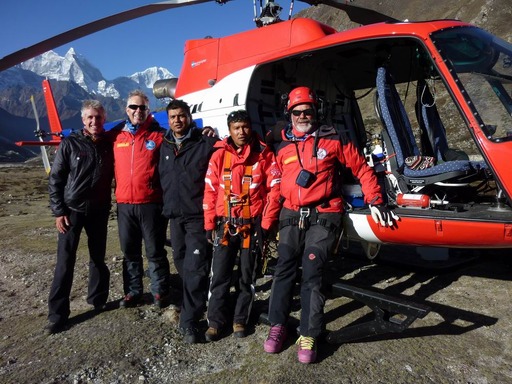 Dario - Gerold - Sabin - Nima - Bruno
Dario - Gerold - Sabin - Nima - Bruno
A rescue in high altitude by helicopter is very difficult and needs the best pilots. At 5.45 h Dario was picked up by helicopter in Khumjung piloted by Gerold Biner from Air Zermatt joined by Chief Pilot Sabin Basnyat from Fishtail Air.

In Periche we made a stop to take the doors out and prepare the long-line-system for rescue-guru Bruno Jelk.
Further up the valley, above Gorak-Shep, we made a deposit with ceresin. Here the long-line-rescue started with Gerold as the pilot and Bruno hanging on the line. All weight was reduced to a minimum and all involved had O2 ready to use as a safety procedure.
 O2 check by very expirienced Bruno Jelk from Zermatt
O2 check by very expirienced Bruno Jelk from Zermatt
At first they got the Russian body out, who was climbing with Alexander and Dario trough the icefall and died soon after below Lhotse. After the Russian, Bruno Jelk and Gerold Biner got also successfully the Swiss body down.
Finally the rescue was a big success. This, thanks the effort of the 8 Sherpa from Active Holidays under the lead of Jyamchang Bhote and Dorjee Sherpa, the knowledge and skill of Bruno and Gerold, the perfect collaboration of the two great helicopter companies Fishtail Air and Air Zermatt and the coordination of Dario from TOPtoTOP.
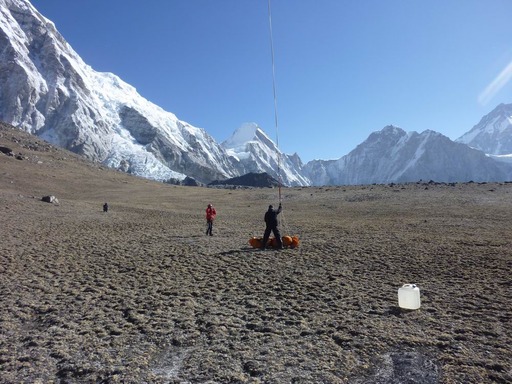
Landing of Swiss body above Gorak Shep, where he is prepared for the flight further to Kathmandu.
In Kathmandu the bodies were in "good hands" with Lhakpa Gyalzen Sherpa. He carried out the further procedures and fulfilled all wishes of the relatives of the two deaths. Many thanks also to him.
May 26, 2010
TOPtoTOP on TOP of the World
English Version coming soon.
 Sonnenaufgang und Schatten des Everest
Sonnenaufgang und Schatten des Everest
 Alexander bei einer Säuberungsaktion im Lager 2
Alexander bei einer Säuberungsaktion im Lager 2
TOPtoTOP Global Climate Expedition Member Alexander Hug aus Sargans erreichte den Gipfel des höchsten Berges der Welt, Mount Everest 8848 m, kurz nach seinem 35. Geburtstag am 23. Mai um 6.36 h. Der Expeditionsleiter Dario Schwörer begleitete ihn bis auf 8000 m, wo er mit seiner Frau Sabine Kontakt hatte, die ihm für den weiteren Aufstieg starke Winde prognostizierte, sodass er sich für die Umkehr entschied und sich auf dem Retourweg erneut aufs Aufräumen konzentrierte.
Der Schwerpunkt der drei monatigen Expedition in der Everestregion waren die Aufräumaktionen mit Freiwilligen und Einheimischen im Khumbutal. Daneben wurden treu der TOPtoTOP-Tradition Schulen besucht, Zeichnungswettbewerbe für ein besseres Klima abgehalten und eine Rettungsaktion vom Südsattel koordiniert. All dies war nur möglich, dank den Hauptsponsoren des TOPtoTOP Everest Clean-up 2010: SGS, Victorinox und Mammut!
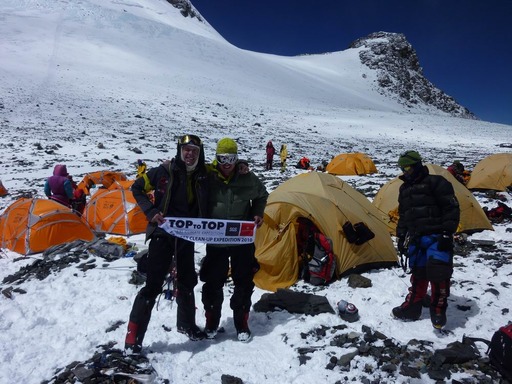 Alexander und Dario im Südsattel
Alexander und Dario im Südsattel
Hier der Tagebucheintrag von Dario über die Zeit der Besteigung:
„Alexander und ich verliessen den Clean up Trupp und ich damit die Familie am 27. April in Khumjung erneut Richtung Everest Basislager. Der Abschied war schwer und es flossen die Tränen.
Sabine hat in ihrem Base Camp, dem Sherpadorf Khumjung, in der Folge die Wetterdaten von Meteotest aus Bern analysiert und uns das Wetter durchgegeben. Das erste Wetterfenster am 17. Mai brauchten wir ja für die Bergung von Gianni. Am 22. Mai sah es mit dem Wind jedoch gut aus. Alexander und ich waren am 19. im Lager 2 und versuchten 2 Sherpas zu gewinnen, die mit uns nonstop vom Lager 2 zum Gipfel gingen; - leider erfolglos. So schlossen wir uns den zwei Österreichischen Bergführern Robert und Sepp an, die am 21.5. ins Lager 3 wollten, nachdem sich die stürmischen Winde vom 20. Mai gelegt hatten. Die Wartezeit nutzten wir wiederum für eine Aufräumaktion im Lager 2. Dank optimalen Bedingungen in der Lhotseflanke kamen wir am 21. gut ins Lager 3 und einen Tag später in den Südsattel. Wir waren beide topfit und freuten uns, da der Gipfel einem von da zum Greifen nahe erscheint.
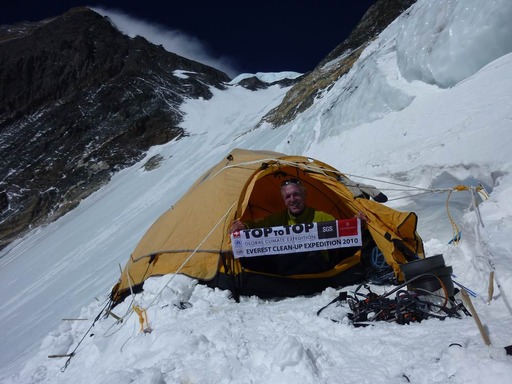 Lager 3 în der Lhotseflanke unterhalb Südsattel mit Everestgipfel im Hintergrund
Lager 3 în der Lhotseflanke unterhalb Südsattel mit Everestgipfel im Hintergrund
Nachdem wir unser Zelt im Lager 4 eingeräumt hatten, lieh mir ein Bergführer aus Alaska gegen eine Tafel Ovo-Schokolade sein Satellitentelefon, damit ich Sabine erreichen konnte. 30 km/h Wind auf dem Gipfelgrat haben wir uns als Grenze gesetzt, nachdem uns renommierte Höhenbergsteiger diese Limite als bewährte Grösse angegeben haben. Mehr Wind, da oben sei fahrlässig, berieten sie uns.
So war ich gespannt auf die Wetterdaten von Sabine und war mir schon sicher, dass der 23. Mai der Tag der Besteigung wird, - nichts stand im Weg für ein super Bergerlebnis.
Wie eine Faust ins Gesicht waren dann die 37 km/h und in einem andern Modell war es sogar 40km/h Wind, die nach Mitternacht auf 8500 m herrschen sollten. Sabine und ich treffen so wichtige Entscheidungen, die unsere ganze Familie hart treffen können, immer gemeinsam. Am Berg wie auf See ging es gerade deshalb in den letzten 8 Jahren unfallfrei, weil wir die Grenzen der Natur respektierten: Beim Start im Jahre 2002 mit Swiss TOPtoTOP, wo wir hauptsächlich auf Skitourenskiern jeden Kantonsgipfel erreichten, mussten wir lernen in einer Hütte auch mal zu warten bis die Lawinengefahr auf "mässig" zurück ging und wir über den nächsten Pass weiterziehen konnten. Das Gleiche ist es auf See, wo wir den sicheren Hafen nicht verlassen, wenn am nächsten Tag eine Sturmfront angekündigt wird und die Ruhe vor dem Sturm einem zum romantischen Auslaufen verleiten will. Wir gehen nicht und bleiben im Hafen.
DieseGedanken und Bilder versuchte ich in diesem harten Moment vor Augen zu halten, konnte die Tränen aber nicht unterdrücken und weinte. Die ganze Mühe mit der Planung bis hin zur Organisation des geeigneten Materials. Dann in grösster Hitze mit dem Fahrrad von Kalkutta durch Indien bis Katmandu und weiter an den Fuss des Everest bis die Strasse fertig war und es dann zu Fuss weiter ging...und jetzt steht man auf 8000 m, mit dem Druck, das letzte Wetterfenster vor dem Monsun zu verpassen, falls man jetzt nicht weiter geht. Es ist doch sonst auch immer gegangen...
Plötzlich bin ich aus meinem Senieren aufgewacht. Es hat Alarmgeschlagen in meinem Kopf. Solche Gedanken sind gefährlich. Was heisst hier "es ist sonst auch immer gegangen"? Ja, es ging immer gut, dank Gottesbewahrung und weil wir die Grenzen der Natur respektierten. Warten können ist Gold, Zeitmangel ist Gift.
In diesem Augenblick sind mir die Worte "ich drehe um" schon über die Lippen gerollt. Ich spürte die Erleichterung bei Sabine auf der anderen Seite des Hörers. Die Last der Verantwortung bei der Analyse der Wetterdaten lag bestimmt schwer. Auch mir fiel ein Stein vom Herzen und mir wurde klar, dass ich Frau und Kinder lieber habe als der höchste Berg der Welt, dass sie für mich das Wichtigste sind auf Erden; - vielleicht das grösste Kompliment eines Bergführers an seine Frau (smile).
Dies war eine meiner härtesten Entscheidung meines Lebens, und ich denke, ich bin darin mehr gewachsen, als wenn ich den Weiteranstieg unter die Füsse genommen hätte.
Ich bin dann zu Alexander gegangen und den beiden österreichischen Bergführerkollegen Robert und Sepp und habe ihnen gesagt, dass ich eine positive und eine negative Nachricht für sie hätte: Die Gute sei, dass sie mehr Sauerstoff hätten und die Schlechte, dass wir uns nicht alle vier auf dem Gipfel in die Arme schliessen können. Sie haben sofort verstanden. Sie wollten den Grund wissen und ich gab Ihnen die Winddaten von Sabine durch. Die Fakten waren auf dem Tisch, der Wind als grösste Gefahr im Endanstieg bekannt, da man sich in der Jetstream-Zone bewegt. Er bläst einem weg bzw. ist in Zusammenhang mit der Kälte Ursache für abgefrorene Finger und Zehen.
Alexander, Robert und Sepp sprachen die Hoffnung aus, dass es sicher nicht so schlimm kommt und dass der Wetterbericht für den 17. Mai ja auch mehr Wind angesagt hätte und dann gab es ja einen Bombentag? Es wurde spekuliert... Ich denke nicht, dass es der Sauerstoffmangel ist, die harte Fakten mit der Höhe aufweichen lassen. Ich denke es ist vielmehr der Wunsch endlich auf dem Gipfel zu stehen, nachdem man schon bald 2 Monate im Basislager auf ein Wetterfenster wartet. Man beginnt dann nur noch das zu Sehen, was man will.
Ich hatte dabei sicher den Vorteil, dass ich selten im Basislager war. Meine Prioritäten lagen anfänglich bei der Aufräumaktion, den Schulbesuchen und dann bei der Bergung des Schweizers vom Südsattel. So war ich abgelenkt und nicht immer auf den Gipfel fixiert. Weiter kam hinzu, dass ich zweimal den langen Weg zur Familie nach Khumjung auf mich nahm. Dies war nicht nur gut für die Fitness, sondern auch fürs Gemüt. Das Lachen der drei Kinder war mein Doping. Ich brauchte keine Infusionen, Pülverchen und Tabletten.
Kurz vor dem Abstieg gingen meine Emotionen in mir doch nochmals hoch. Es brodelte in mir. Ich habe mich so genervt: So nahe dran, gesund und fit, nach bald 3 Monaten in der Region super akklimaitsiert und gegenüber den 150 anderen Bergsteigern, die auch im Südsattel übernachteten, mussten sich Alexander und ich konditionell bestimmt nicht schämen. Ich wollte doch den Clean-Up-the-World-Sack unbedingt zum Gipfel nehmen? Ich fragte mich, ob ich in meinem Leben wohl nochmals so fit sein werde?....aber eben der verfluchte Wind.
Aber dann, einen Augenblick später, war ich plötzlich auch etwas stolz und wusste, wenn ich unter diesen Voraussetzungen am Everest umkehren kann, dann kann ich es überall und ich spürte die Essenz des Überlebens und hob meine Füsse und schlug die Steigeisen mit Frontzacken nach unten ins Eis. Wir umarmten uns gegenseitig ein letztes Mal unter Tränen. Ich nahm meinen Abfallsack in die Hand, nahm symbolisch auch etwas Abfall vom Südsattel mit und begann ein schneller Abstieg durch die Lhotse Flanke getrieben von Frau und Kinder weit unten im Tal. Ich ging hoch konzentriert und vorsichtig, kontrollierte die Verankerung jeder Abseilstelle und hängte mich in jedes bestehende Fixseil ein und hatte weiter unten Gottes Bewahrung im Eisabbruch, als ein Serac vor mir zusammenstürzte. - Ich weiss, dass Gott einem Hilft, wenn man seine Aufgabe sorgfältig und gewissenhaft macht. - Sabine, Salina, Andri und Noé sind meine beste Lebensversicherung und ich weiss nach diesem Erlebnis, dass ich immer zu ihnen zurückkehren werde. Nach 3 Tagen konnten wir uns im Sherpa-Dorf Khumjung alle wieder in die Arme schliessen.
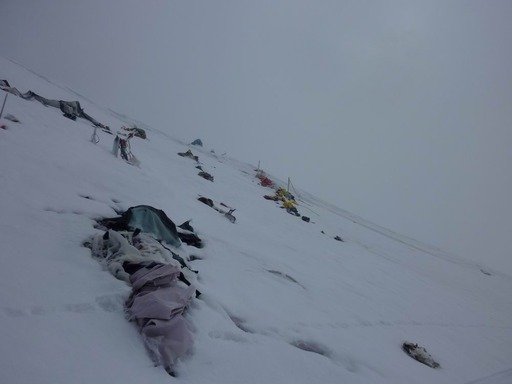 Reste von Zelten im Lager 3 nach einem Sturm
Reste von Zelten im Lager 3 nach einem Sturm
Die andern gingen am frühen Abend des 22. Mai los Richtung Gipfel. Jeder begleitet von einem Sherpa mit zusätzlichem Sauerstoff. Ich gab Ihnen den Tipp schnell zu sein, da die Winde nach Mitternacht gemäss Prognose zunehmen würden. Leider gab es noch 150 andere Bergsteiger, d.h. man kann nicht sein eigenes Tempo gehen. Jeder ist am Fixseil, wie im Gänsemarsch geht's im Zeitlupentempo Schritt für Schritt in die Unendlichkeit der Dunkelheit. Hat jemand weiter vorne eine Schwäche stockt dies die ganze Kolone. Kommt der Hillary Stepp gibt es sowieso Stau, weil nicht alle wirkliche Kletterer sind. Alexander erzählte mir, dass sie deshalb erst gegen 6.36 h auf dem Gipfel waren. Sepp hätte sich an 3 Fingern Erfrierungen geholt und er selber hätte etwas mit den Zehen. Er denkt aber, dass es nicht weiter schlimm sei. Nach der kalten und strengen Nacht kamen sie dann am 23. Mai wieder zurück zum Südsattel. Dorjee Sherpa erzählte mir, dass sie dort nochmals übernachteten, da sie wegen dem starken Wind die Zelte nicht abbrechen konnten. Erst am 24. Mai ist der Weiterabstieg möglich. Am Abend erreiche ich Alexander und gratuliere ihm und den beiden Österreichern Robert und Sepp zum Gipfelerfolg und wünsche ihnen schnelle Besserung der Zehen und Finger. Alexander sagt mir, dass er sehr müde sei und sich nun weiter unten auf ein Yak Steak freue...
Am Abend im Bett fragt mich Sabine, ob ich nicht enttäuscht bin, doch nicht oben gewesen zu sein. Ich flüstere ihr ins Ohr: Der Wind hat entschieden, derselbe gute Wind der die Pachamama über all die Meere getragen hat. Er ist stärker als wir, und es ist gut, ihn als Freund zu haben. Die Wahrscheinlichkeit, dass eine Wetterprognose eintrifft ist höher, als dass sie nicht eintrifft und damit haben wir gemeinsam richtig entschieden. Denn wäre ich weitergegangen und die Prognose wäre eingetroffen und etwas wäre passiert, - dann wäre unser Freund der Wind, für immer zu unserem Feind geworden..."
 Sabine's Tagebuch mit Wetteranalyse
Sabine's Tagebuch mit Wetteranalyse
May 31, 2010
TOPtoTOP on TOP of the World (English Version)
Download the Swissnex Annual Report 2009
Thanks to Hanna Law from the Rotary Club of Yankalilla, Australia here the translation in English. The Rotary Club of Yankalilla set an example and donate colours to poor Nepali schools trough the TOPtoTOP fondation. Congratulation!
Translation by Hanna Law, for pictures check report from the 27th of May:
"TOPtoTOP Global Climate Expedition Member Alexander Hug of Switzerland reached the summit of the highest mountain in the world, Mount Everest (8848m) shortly after his 35th birthday on 23 May at 06.36 hours. Expedition leader Dario Schwörer accompanied Alexander to 8000m, where he contacted his wife Sabine. Sabine provided a weather report forecasting strong winds for the remainder of the climb, and as a result, Dario decided that he would turn around and descend, concentrating instead on his clean-up project.
The clean-up project with volunteers and locals in Khumbutal was the focus of our three months in the Everest region. We also visited local schools in the TOPtoTOP tradition, where we held drawing competitions for a better climate, and we coordinated a rescue operation from the South Col.
Here is an extract from Dario's diary, written during the ascent of the mountain:
Alexander and I left the Clean Up Troupe and my family on 27 April in Khumjung again heading for the Everest Base Camp region. The parting was very hard and our tears flowed freely.
Sabine, in her base camp at Khumjung, analysed the weather data from Meteotest in Bern in the Sherpa Village simultaneously and then broadcast the weather forecast through to us. Our first weather 'window' on 17 May was required for the recovery of Gianni's body. The winds forecast for the 22 May looked favourable. On 19 May Alexander and I were in Camp 2, and tried very hard to engage two Sherpas to ascend with us from Camp 2 to the Summit - unfortunately we were unsuccessful in our attempt. Instead we joined forces with the two Austrian mountain guides, Robert and Sepp, who had planned to be in Camp 3 on 21 May after the stormy winds had abated. We used the waiting time to clean up around Camp 2. Thanks to optimal conditions on the Lhotse face, we made it safely to Camp 3 by 21 May and a day later we reached Everest South Col. We were both extremely fit, and we rejoiced because the Summit appears so near from this point.
After we had set up our tent, a guide from Alaska lent me his satellite phone in return for a block of Ovo chocolate so that I could reach Sabine. We had set ourselves a 30 km/h wind limit on the Summit Ridge, as this is the safe maximum wind speed recommended and proven by renowned mountain climbers. They warned us that climbing in winds higher than this limit would be dangerous and it would be negligent to climb in those circumstances.
I was looking forward to the weather data from Sabine, and I was already certain that the 23 May would be the day of the ascent - nothing stood in the way of a super mountain experience.
So it was like a fist in the face to receive the news that wind speeds of 37 km/h were predicted for after midnight at 8500m - in fact, in another model, predictions were even higher at 40 km/h. Sabine and I always make difficult decisions that may affect our family together. From mountain to sea, our last eight years has been accident free because we respect the limits of nature. When we started the Swiss TOPtoTOP Expedition in 2002 where we reached each Canton summit on cross country skis, we had to learn to wait in a hut until the danger of avalanches had moderated. It is also the same at sea: we remain in port when we hear that a storm front is approaching the next day, even though the calm before the storm entices us to romantically sail away. We do not leave. We stay in port.
I tried very hard to keep these thoughts and mental pictures foremost in my mind, but at the same time I could not suppress my tears and cried. All the effort of planning, the organisation of appropriate material. Then cycling in extreme heat from Kolkata through India to Kathmandu, and then on to the base of Mt Everest until we came to the end of the road, where we continued on foot... and now I'm stuck at 8000m, with mounting pressure not to miss the last weather 'window' before the monsoon sets in if we want to go further. It has always been this way...
Suddenly I awake from my reflections. Alarm bells are ringing in my head. Such thoughts are dangerous. What does 'It has always been this way' mean? Yes, everything always went well thanks to God's grace, and as long as we always respected the boundaries of nature. Being able to wait is gold - lack of time is poison.
In this instant, the words 'I will turn back' rolled across my lips. I felt Sabine's relief on the other end of the receiver the burden of responsibility for analysing the weather was great. The weight lifted from my heart too, and it was clear to me that having a wife and children rather than climbing the highest mountain in the world was the most important thing on earth to me... perhaps the biggest compliment a mountain guide can pay his wife.
This was one of the hardest decisions of my life and I think I have grown more by making that decision than if I had decided to continue the climb.
I then went to Alexander and our two Austrian mountain guide colleagues, Robert and Sepp, and told them that I had good news and bad news. The good news was that there was more oxygen available and the bad news was that we would not all four be standing together arm-in-arm on the summit. They understood immediately. They wanted to know the reason for my decision, so I gave them the wind data that I had received from Sabine. The facts were on the table: the wind poses the greatest danger in the final stages of the climb because it is in the Jetstream zone. It can blow one away, or is the cause for frostbitten fingers and toes because of the extreme cold.
Alexander, Robert and Sepp spoke of their hope that the wind would not be that bad, and that the weather forecast for 17 May had predicted even stronger winds, and yet the day turned out to be spectacular. It (the weather forecast) is speculation... I don't think that the lack of oxygen can weaken the hard facts at such heights. I think rather it is the desire to finally stand at the Summit after waiting two months in Base Camp for suitable weather. In the end you begin only to see what you want to see.
I had the advantage that I had rarely been in Base Camp. My priority lay in cleaning up the area, visiting schools and the retrieval of the Swiss from the South Col. So I was distracted and not always fixating on the Summit. Also, I had twice made the long journey to Khumjung to visit my family. This was not just good for my fitness, but also for my disposition. The laughter of my three children was my drug of choice. I did not need infusions, powders or tablets.
Shortly before the descent my emotions rose once again. They seethed in me. I have been so nervous, so close, so fit and healthy. I spent three months in the region getting extremely acclimatised and Alexander and I had been determined not to shame ourselves in comparison to the other 150 mountain climbers who also stayed in the South Saddle. Surely I really wanted to take the Clean-Up-the-World sack to the top of the world? I asked myself if I would ever be this fit again in my life... and yet, that cursed wind!
But then, a moment later, I was suddenly rather proud and knew that if I could make the decision to turn back, then I could do anything and I felt the essence of survival and raised my feet and struck the crampons into the ice with front points facing down the mountain. We hugged each other one last time, in tears. I took my waste bag in hand, symbolically took along some waste from the South Saddle, and began a rapid descent through the Lhotse flank driven by my wife and children far down in the valley. I was highly focussed and careful, controlling the anchoring in each descent position, suspended myself in each existing fixed rope, and at one stage had God's preservation when a Serac (a sharp pinnacle of ice among the crevasses of a glacier) collapsed before me. I know that God helps one when one carries out tasks thoroughly and conscientiously. Sabine, Salina, Andri and Noé are my best life insurance, and I know that after this experience I will always return to them. After three days we could once again cling together in each other's arms.
In the early evening of 22 May, the others headed in the direction of the summit. Each climber was accompanied by a Sherpa with additional oxygen. I gave a tip to travel quickly because the winds were predicted to increase in speed after midnight. Unfortunately there are 150 climbers in all, so it is impossible to climb at one's own speed. Each climber is attached to the fixed rope and they move in single file, like a line of geese, in slow motion, step for step into the infinity of darkness. If someone at the front is overcome by weakness, then the whole column comes to a standstill. At the Hillary Step there is always a traffic jam anyway, because not all are true climbers. Alexander told me that it was already 06.36 hours when they reached the summit. Sepp had frostbite on three fingers, and Alexander believed he had frostbite on his toes, although he also believed that it was not serious. After a cold and difficult night, they arrived back at the South Saddle on 23 May. Dorjie Sherpa told me they stayed there again because they could not disassemble the tents due to the strong wind. Only on 24 May was it possible to continue. I managed to contact Alexander in the evening, and congratulated him and the two Austrians, Robert and Sepp, on their successful climb to the summit. I wished them a speedy recovery from their frostbite. Alexander told me that he was very tired and would now be very happy to have a yak steak on reaching lower altitude...
That night in bed, Sabine asked me if I was disappointed not to have reached the summit of Everest. I whispered in her ear: the wind made the decision the same good wind that has carried our sailboat Pachamama over the seas. It is stronger than us, and it is good to have it as a friend. The probability that a weather forecast is right is higher than that it is wrong, and therefore we made the right decision together. If I had climbed further and then received a bad weather, and then something had gone wrong, then our friend the wind would forever after be our enemy...."


